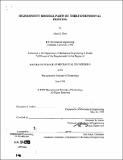| dc.contributor.advisor | Emanuel M. Sachs. | en_US |
| dc.contributor.author | Oton, Akan E., 1974- | en_US |
| dc.date.accessioned | 2010-01-07T20:42:11Z | |
| dc.date.available | 2010-01-07T20:42:11Z | |
| dc.date.copyright | 1998 | en_US |
| dc.date.issued | 1998 | en_US |
| dc.identifier.uri | http://hdl.handle.net/1721.1/50462 | |
| dc.description | Thesis (S.M.)--Massachusetts Institute of Technology, Dept. of Mechanical Engineering, 1998. | en_US |
| dc.description | Includes bibliographical references (p. 102-103). | en_US |
| dc.description.abstract | Three Dimensional Printing (3DP) is a rapid prototyping process that allows for the fabrication of injection molding tooling from computer generated models. Due to market demands for harder, more robust tooling, improving the material properties and the geometric control of 3DP parts has been a necessary goal of the project. One path to accomplishing this task is to increase the green density of the 3DP compact prior to sintering. To accomplish this goal, the printing of fine, sub-micron Titanium Carbide slurries into a large powder bed to create a dense bimodal compact was investigated. Experiments performed demonstrated that a uniform, defect free microstructure could be obtained by appropriately selecting 3DP process parameters. By spreading 4 mil layers, and double printing, sample coupons with estimated green densities of up to 83% were obtained. In addition, the effect of varying either the bimodal concentrations or the relative particle sizes, on fine porosity in 3DP parts after infiltration was studied. Three bimodal ceramic-metal material systems, each based on Titanium Carbide and subsequently infiltrated with a copper-nickel-manganese alloy, were also developed. The first system, a bimodal system of large TiC and fine TiC powders exhibits good dimensional control (net shrinkage of 0.2%) and age-hardening properties (up to 43 HRC). The second system, a bimodal system of large Stainless Steel and fine TiC powders, is characterized by modest dimensional control (less than 2%), but does not exhibit any age-hardening behavior. The third system developed, a bimodal system of large Molybdenum powders and fine TiC powders, can be hardened up to 25 HRC with a 12 hour 400°C treatment. | en_US |
| dc.description.statementofresponsibility | by Akan E. Oton. | en_US |
| dc.format.extent | 109 p. | en_US |
| dc.language.iso | eng | en_US |
| dc.publisher | Massachusetts Institute of Technology | en_US |
| dc.rights | M.I.T. theses are protected by
copyright. They may be viewed from this source for any purpose, but
reproduction or distribution in any format is prohibited without written
permission. See provided URL for inquiries about permission. | en_US |
| dc.rights.uri | http://dspace.mit.edu/handle/1721.1/7582 | en_US |
| dc.subject | Mechanical Engineering | en_US |
| dc.title | High density bimodal parts by three dimensional printing | en_US |
| dc.type | Thesis | en_US |
| dc.description.degree | S.M. | en_US |
| dc.contributor.department | Massachusetts Institute of Technology. Department of Mechanical Engineering | en_US |
| dc.identifier.oclc | 42192334 | en_US |
